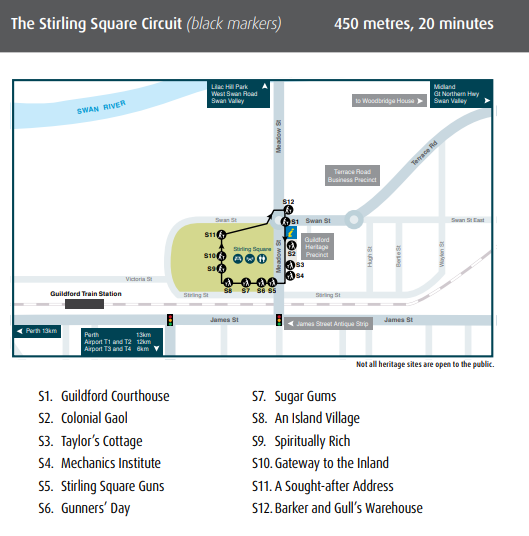Guildford Heritage Walking Trails
- Out and About
- Mar 30, 2018
- 7 min read
Updated: Mar 3
Revised November 2023

Guildford was established during the founding of the Swan River Colony in 1829 and today is one of only three towns in Perth on the National Trust register. Established on what is virtually an island encircled by the Swan and Helena Rivers, Guildford is ideally suited to explore on foot. Much of Guildford’s original town plan, including the central church square (now known as Stirling Square), remains largely intact allowing a rare glimpse into early colonial settlement.
Starting from the Old Guildford Courthouse (home of the Swan Valley Visitor Centre) in the centre of Guildford's Heritage Precinct there are 4 different heritage walks you can follow around the townsite, ranging from 450 metres to 2250 metres in length. You can also combine the walks in a loop which will take about 2 hours at an easy pace, depending on how long you stop to read the information signs along the way. Each trail is marked with coloured markers directing you to the next information plaque. The walks follow footpaths so are easily accessible for prams or wheelchairs and have the added advantage of passing under beautiful sugar gum trees providing shade. There are plenty of interpretive panels along the way to inform you about the historical relevance of the various buildings you are passing by. A map of the walk trails can be picked up from the Swan Valley Visitor Centre or download at https://www.swanvalley.com.au/Business-Listings/Guildford-Heritage-Walk-Trails

The Captain Stirling Walk

Starting from the Guildford Courthouse this trail follows Swan Street past the grounds of the former Bell Bros business to the Terrace Street business precinct and the beautifully restored Rose and Crown Hotel (c.1841), Western Australia’s oldest continually operating pub, and Padbury’s Store (c.1869). It passes a number of historic cottages and looks out over what was Captain James Stirling’s beloved Woodbridge Estate on the Swan River floodplain.

A highlight of the trail are the picturesque grounds of Guildford Grammar School, set amidst the shade of magnificent London Plane trees. Founded by Charles Harper in 1896, this prestigious co-ed school provides an Australian interpretation of the traditional English public school education system and many of it's students have become prominent State and Australian citizens.

Located within the school grounds is the imposing Chapel of St Mary and St George, consecrated in 1914 and today one of the finest examples of Gothic architecture in Australia. Visitors to the Chapel must report to the Guildford Grammar administration building.

Old East Guildford cemetery formed part of the original churchyard of a small wattle and daub church built in 1836 a few yards east of the current Chapel of St Mary and St George.
The cemetery was used from 1830 until 1918. In 1949 the cemetery was transferred to the Crown for the purpose of road widening and in 1953 the remaining headstones were collected together and set in the cruciform layout.
The trail returns along Allpike Street and Swan Street passing heritage cottages and the old agricultural showground.

An alternative is to cross the railway line and follow Great Eastern Highway south passing the Woodbridge Hotel and then passing Fauntleroy Park and St Mary's Catholic Church before joining the Town Walk at the corner of James Street (Great Eastern Highway) and Meadow Street. We had walked this section when we explored River Bank Reserve.
The Town Walk

This trail also starts from the Guildford Courthouse and explores the historic Meadow Street precinct with it's Colonial Gaol and Taylors Cottage.
The Colonial Gaol is an important example of early architecture largely constructed by convict labour. The original building was constructed in 1841 then in 1851 police married quarters, a living room, a justice room and seven cells were added. A bigger magistrate’s room was built on in 1853. More changes took place with new cells and a prisoners’ day room added in 1867 and a big exercise yard in 1868. The Colonial Gaol was used as a police station until 1969. During opening hours visitors have a chance to learn about law and order in colonial times and walk inside a gaol cell, complete with toilet bucket in the corner!
Taylor’s Cottage is a perfectly preserved building showing how the Taylor family lived in the late 19th Century. It is reported that 13 children grew up there - many of them sleeping on the verandahs. Peek inside the rare weatherboard wash house and wood shed dating from 1913 and see what was involved in doing the weekly wash 100 years ago using the washing copper and mangles.
The Swan Guildford Historical Society opens these attractions Tuesday to Saturday (closed Thursdays) from10am-2pm. Adult entry is $5 and children are $3 - under fives are free

The trail then continues past the Mechanics Institute and Post Office which also feature on The Stirling Square Circuit Trail.
The Guildford Mechanics Institute was formed in 1862 by the gentry of the Swan District to improve the general education for the working/trades men of the town. The building was commenced in 1865 and was the first public hall in the Swan district.
The Guildford Post Office was built in 1898 to service the growing agricultural hub on the Swan River. The clock tower was added in 1901. The current owners have restored the building and added a gallery and garden centre to the building and also operate a lovely French inspired cafe, Poste Cafe. This unique place is well worth a visit to look around or to enjoy a cuppa or a meal.

From the site of the Convict Depot divert along James Street to the Wesley Church and Manse. The Convict Depot, established in 1851, housed convicts and later, ‘Ticket of Leave’ men (who had been granted parole). They built roads, houses, bridges and other public works and helped to establish the town..

Get a closer look at the art deco Town Hall (1937) and Council Chambers.

Continue along Meadow Street with the Stirling Arms on one side and the Commissariat Store and Quarters (now the Garrick Theatre), built with convict labour in the 1850's, on the other. Garrick Theatre was established in 1932 and is the longest continuously running community theatre in metropolitan Perth.

Meadow Street is home to heritage homes, the Kings Cottage and Shop and the Fire Station...

At the bottom of Meadow Street is Kings Meadow which was set aside as public land fronting the Helena River. The area now operates as a Polo Club. We have explored the walk trail along the Helena River to Fishmarket Reserve on the Swan River on a previous occasion. Read more about this lovely walk on our Markets and Meadows - Guildford blog.

The trail then heads west along Helena Street, crossing over Johnson Street (Great Eastern Highway) and turning right at Stephen Street after passing Western Australia’s oldest continually operating primary school . The trail then follows James Street east through the shopping precinct where you can pause for a coffee or a meal and browse the antique shops.



There is also the Museum of Natural History which features a huge range of animals, past and present. See related blog https://outandaboutfnc.wixsite.com/outandabout/single-post/2018/03/30/Museum-of-Natural-History.

The River Ramble

This trail overlaps The Captain Stirling Walk as it passes the grounds of the former Bell Bros business, the historic Rose and Crown Hotel (c.1841) and Padbury’s Store (c.1869). Walter Padbury was Guildford’s first mayor (in 1887) and one of Western Australia’s most successful early entrepreneurs - at one time, the biggest landowner in the colony!
Back at the corner of Meadow Street and Swan Street is Barker and Gull’s Warehouse, an example of the numerous retail and wholesale businesses that existed in Guildford during the height of the town’s importance as a port and market town to the Swan River colony.
The trail follows Meadow Street towards the Swan River passing St Charles' Seminary which opened in 1942 on a property known as Garden Hill.

The footpath then leads to Moulton’s Landing established in 1829 on the banks of the Swan River and used as a public wharf allowing barges and river craft to transport goods to the settlement.

Walking back from the Swan River you pass more heritage homes on Meadow Street and along Swan Street before entering Stirling Square where you can join the Stirling Square Circuit Trail.

The Stirling Square Circuit

A shorter walk for those with less time, this trail incorporates the best of the historic Meadow Street precinct including the Colonial Gaol (c.1841), the Courthouse (c.1866) and Taylor’s Cottage. It passes the Mechanics Institute, established in 1865 to provide education for the working men of the town. The building has always had a strong connection with Guildford community life. and continues to be used for entertainment and educational activities.
The trail then loops out into the lovely parkland of Stirling Square where the Rose Garden reflects that Guildford was known as the town of roses in the 1930s.
Here under towering sugar gums interpretive panels provide an insight into old Guildford town.

St Matthew’s Church, one of Western Australia’s best examples of Gothic Revival architecture, is located in the exact centre of Guildford and within Stirling Square.
The park is a traditional Aboriginal meeting place and home to Guildford's War Memorial.
Another trail to follow is the Guildford Anzac Trail, a trail of red poppies that brings the ANZACS to life by taking you to the homes where they lived, showing you who lived there and providing links to information about the individual ANZAC.

There is a small nature playground located in Stirling Square in the centre of Guildford
or head to nearby Woodbridge Riverside Park which has an amazing playground.

You can spend an hour or a day exploring this beautiful heritage town. There are many amazing historic places to stop for a meal or a hot or cold beverage. Parking is available through the town precinct with some time limited areas. Toilets are available at Stirling Square and at the Swan Valley Visitor Centre.
To read more blogs go to:
I love wandering along trails, both marked and unmarked, and sharing my discoveries with my Out and About FNC community. If you enjoy reading my blogs please consider a small donation which will be used towards the costs of keeping the website up to date and relevant.

In the spirit of reconciliation Out and About- Family Nature Connection acknowledges the traditional owners of the Wadjak boodjar (Perth land) and their connections to land, sea and community. We pay our respect to their elders past and present and extend that respect to all Aboriginal and Torres Strait Islander peoples today.











